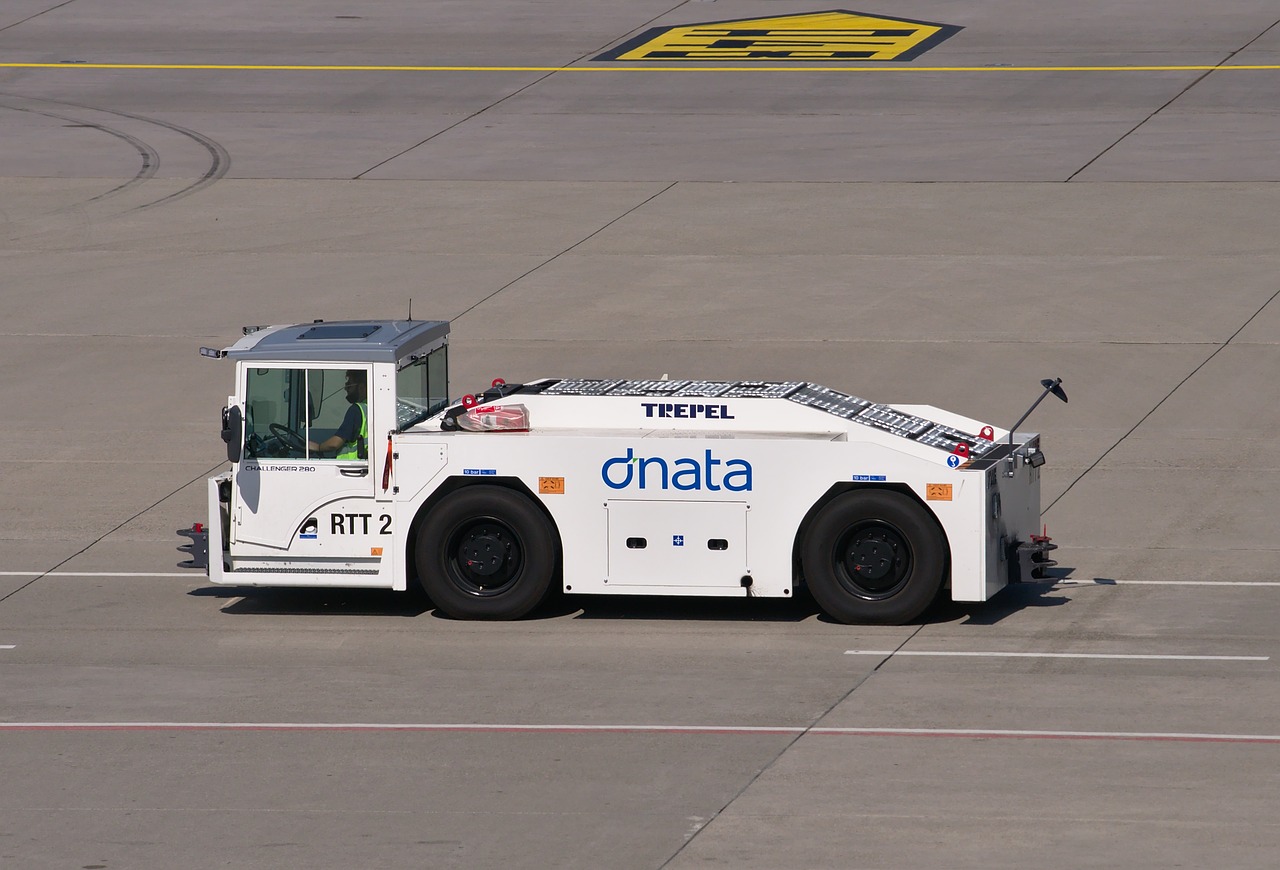Exploring the Future of Autonomous Logistics Vehicles
The world of logistics is undergoing a dramatic transformation, and at the heart of this evolution are autonomous logistics vehicles. These advanced machines are not just a glimpse into the future; they represent a significant shift in how goods are transported and delivered. Imagine a world where delivery trucks operate without human intervention, efficiently navigating through traffic, weather conditions, and complex urban environments. This isn't science fiction—it's rapidly becoming a reality.
As we delve into the advancements, challenges, and implications of autonomous logistics vehicles, it's essential to recognize their potential to revolutionize supply chains. With the rise of e-commerce and consumer demand for faster deliveries, traditional logistics methods are being pushed to their limits. Autonomous vehicles promise to enhance efficiency, reduce costs, and improve safety in the transportation sector. But what exactly does this mean for businesses and consumers alike?
At the core of this revolution are cutting-edge technologies such as artificial intelligence (AI), machine learning, and advanced sensors. These innovations enable vehicles to operate safely and effectively in a variety of environments. For instance, AI algorithms can analyze vast amounts of data in real time, allowing vehicles to make split-second decisions that enhance their operational capabilities. Meanwhile, advanced sensors help vehicles detect obstacles, navigate complex routes, and ensure compliance with traffic regulations.
As we explore the future of autonomous logistics vehicles, we’ll uncover how these technologies are not just improving the way we transport goods but also reshaping the entire logistics landscape. From cost reductions to enhanced safety measures, the implications are profound. However, the journey towards widespread adoption is not without its challenges, including regulatory hurdles and technological limitations that need to be addressed. So, buckle up as we navigate through this exciting terrain and discover what lies ahead!
- What are autonomous logistics vehicles? Autonomous logistics vehicles are self-driving vehicles designed to transport goods without human intervention.
- How do they enhance efficiency? They optimize routes, reduce delivery times, and minimize human error, leading to improved operational efficiency.
- What challenges do they face? Regulatory issues, technological barriers, and public acceptance are some of the key challenges to widespread adoption.
- How will they impact the job market? While they may reduce certain jobs, they can also create new roles in technology management and vehicle maintenance.
- Are they safe? Autonomous vehicles are designed with advanced safety features that aim to reduce accidents caused by human error.

Technological Innovations
The world of autonomous logistics vehicles is buzzing with excitement, and it's all thanks to a wave of that are reshaping the way we think about transportation. Imagine a future where trucks and delivery drones navigate bustling city streets without a human at the wheel. Sounds like science fiction, right? But with advancements in artificial intelligence (AI), machine learning, and advanced sensor technologies, this dream is quickly becoming a reality. These innovations are not just enhancing the functionality of logistics vehicles; they are revolutionizing the entire supply chain ecosystem.
At the heart of these advancements is artificial intelligence. AI algorithms are being developed to analyze vast amounts of data, enabling vehicles to make real-time decisions. For instance, when an autonomous truck approaches a busy intersection, its AI system can process data from multiple sources—traffic signals, pedestrian movements, and road conditions—to determine the safest and most efficient route. This level of decision-making mimics human thought processes but operates at lightning speed, significantly reducing the chances of accidents.
Another critical component is machine learning. This technology allows vehicles to learn from their experiences, continuously improving their performance over time. For example, if an autonomous delivery drone encounters a new type of obstacle during its flight, it can analyze the situation and adapt its flight path for future deliveries. This self-learning capability is akin to how humans improve their skills through practice, making logistics vehicles smarter and more reliable.
Furthermore, advanced sensors play a pivotal role in the operation of these vehicles. Equipped with an array of sensors such as LIDAR, radar, and cameras, autonomous vehicles can perceive their surroundings with remarkable accuracy. These sensors work together to create a detailed 3D map of the environment, allowing the vehicle to detect obstacles, identify road signs, and gauge distances. The synergy between these technologies ensures that autonomous vehicles can navigate complex environments safely and efficiently.
To illustrate the impact of these technological innovations, consider the following table that summarizes key technologies in autonomous logistics:
| Technology | Description | Impact on Logistics |
|---|---|---|
| Artificial Intelligence | Algorithms that enable real-time decision making | Improves route optimization and safety |
| Machine Learning | Self-learning systems that adapt based on experience | Enhances reliability and efficiency over time |
| Advanced Sensors | Technologies like LIDAR and cameras for environmental perception | Enables safe navigation in diverse conditions |
In conclusion, the technological innovations driving the development of autonomous logistics vehicles are nothing short of groundbreaking. These advancements not only promise to make transportation safer and more efficient but also pave the way for a future where logistics operations are seamlessly integrated with smart technologies. As we continue to explore this exciting frontier, it’s clear that the potential for autonomous logistics vehicles is vast and filled with opportunities that can transform the way goods are transported worldwide.
- What are autonomous logistics vehicles?
Autonomous logistics vehicles are self-driving vehicles designed for transporting goods without human intervention, utilizing advanced technologies like AI and sensors.
- How do these vehicles improve efficiency?
By optimizing routes, reducing human errors, and operating continuously without breaks, autonomous vehicles significantly enhance the efficiency of logistics operations.
- What challenges do autonomous vehicles face?
Challenges include regulatory hurdles, technological limitations, and public acceptance, which need to be addressed for widespread adoption.
- Are autonomous logistics vehicles safe?
Yes, they are designed to enhance safety by reducing human error and implementing advanced safety protocols, though ongoing improvements are necessary.

Benefits of Autonomous Logistics
The rise of autonomous logistics vehicles is not just a trend; it’s a game-changer for the entire transportation industry. Imagine a world where goods move seamlessly from one location to another, without the delays and inefficiencies associated with human drivers. Autonomous vehicles are equipped with cutting-edge technology that enhances their operational capabilities, leading to a plethora of benefits that can transform supply chains.
One of the most significant advantages of autonomous logistics vehicles is their increased efficiency. These vehicles can operate 24/7 without the need for breaks, sleep, or downtime. This continuous operation means that deliveries can be made faster and more reliably. For instance, consider a delivery truck that can navigate through traffic and optimize its route in real-time. With advanced algorithms and machine learning, these vehicles can analyze traffic patterns and weather conditions to ensure the quickest delivery times. This level of efficiency not only enhances customer satisfaction but also boosts overall productivity.
Another compelling benefit is the reduction in operational costs. Companies are always on the lookout for ways to cut expenses, and autonomous vehicles provide a solution. By eliminating the need for human drivers, businesses can save significantly on labor costs. Additionally, autonomous vehicles are designed to be fuel-efficient, utilizing advanced technologies that optimize fuel consumption. This is crucial in an era where fuel prices are volatile and environmental concerns are at the forefront. The table below illustrates the potential cost savings from implementing autonomous logistics:
| Cost Category | Traditional Logistics | Autonomous Logistics |
|---|---|---|
| Labor Costs | $50,000/year per driver | $0 (eliminated) |
| Fuel Costs | $1.50/mile | $1.20/mile |
| Maintenance | $0.10/mile | $0.08/mile |
Moreover, the safety improvements offered by autonomous logistics vehicles cannot be overlooked. Human error is a leading cause of accidents on the road, but autonomous vehicles are designed to minimize this risk. Equipped with advanced sensors and real-time data analytics, these vehicles can make split-second decisions to avoid obstacles and respond to changing conditions. For example, if an unexpected object appears in the road, an autonomous vehicle can react faster than a human driver, significantly reducing the likelihood of accidents. This enhanced safety not only protects the goods being transported but also ensures the safety of other road users.
In addition to safety, the environmental impact of autonomous logistics vehicles is another noteworthy benefit. With their ability to optimize routes and improve fuel efficiency, these vehicles contribute to a smaller carbon footprint. As companies strive to meet sustainability goals, integrating autonomous vehicles into their logistics operations can play a vital role in reducing emissions. This shift not only helps the planet but also aligns with consumer preferences for eco-friendly practices.
In conclusion, the benefits of autonomous logistics vehicles are multifaceted, encompassing efficiency, cost savings, safety, and environmental sustainability. As technology continues to advance, the potential for these vehicles to revolutionize the logistics industry becomes increasingly apparent. Companies that embrace this innovation will likely find themselves at the forefront of a new era in transportation.
- What are autonomous logistics vehicles?
These are self-driving vehicles designed to transport goods without the need for a human driver. - How do autonomous vehicles improve safety?
They utilize advanced sensors and real-time data to minimize human error and respond quickly to potential hazards. - What cost savings can companies expect?
Companies can save on labor costs, fuel expenses, and maintenance, leading to lower overall operational costs. - Are autonomous logistics vehicles environmentally friendly?
Yes, they often use fuel-efficient technologies and optimized routing to reduce emissions.

Cost Reduction
When we talk about the future of logistics, one of the most exciting aspects is how autonomous vehicles can lead to significant cost reductions across the board. Imagine a world where delivery trucks operate around the clock without the need for human drivers. This isn’t just a dream; it’s becoming a reality. By implementing these high-tech vehicles, companies can drastically lower their operational costs, resulting in a more competitive edge in the market.
First off, let’s dive into the labor savings. Traditional logistics operations often rely heavily on human labor, which can be quite costly. With autonomous vehicles, companies can minimize labor costs dramatically. This allows businesses to reallocate those resources to other critical areas, such as research and development or customer service. It’s like having your cake and eating it too—more efficiency and less expenditure!
Next, we have the aspect of fuel consumption. Autonomous vehicles are designed to optimize routes and driving patterns, which can lead to significant fuel savings. For example, studies have shown that these vehicles can reduce fuel usage by up to 20% compared to conventional trucks. This not only cuts costs but also contributes to a greener environment. Imagine the positive impact on your bottom line and the planet when your logistics operations become both efficient and eco-friendly.
Moreover, let’s not overlook maintenance costs. Autonomous vehicles are equipped with advanced sensors and diagnostic tools that continuously monitor their performance. This means that potential issues can be identified and addressed before they escalate into major problems. By being proactive, companies can save substantial amounts on maintenance and repairs, which can be a significant drain on resources in traditional logistics setups.
To give you a clearer picture, here’s a quick breakdown of how autonomous logistics vehicles can reduce costs:
| Cost Factor | Traditional Vehicles | Autonomous Vehicles | Potential Savings |
|---|---|---|---|
| Labor Costs | High | Low | Up to 30% |
| Fuel Consumption | Standard | Optimized | Up to 20% |
| Maintenance | Frequent Repairs | Predictive Maintenance | Up to 25% |
As you can see from the table above, the potential savings are not just theoretical; they have real implications for businesses looking to thrive in a competitive landscape. By embracing autonomous logistics vehicles, companies are not just investing in technology; they are investing in their future.
In conclusion, the associated with autonomous logistics vehicles is a game changer. It allows businesses to streamline their operations, enhance their profitability, and focus on growth. So, if you’re still on the fence about this technology, consider the financial benefits it can bring. After all, in the fast-paced world of logistics, every penny counts!
- What are autonomous logistics vehicles? Autonomous logistics vehicles are self-driving trucks and delivery systems designed to transport goods without human intervention.
- How do autonomous vehicles reduce costs? They reduce costs by minimizing labor expenses, optimizing fuel consumption, and lowering maintenance costs through advanced monitoring systems.
- Are autonomous vehicles safe? Yes, they are equipped with advanced safety features that minimize human error and enhance overall safety in logistics operations.
- What challenges do autonomous vehicles face? Challenges include regulatory hurdles, technological limitations, and public acceptance that need to be addressed for widespread adoption.

Fuel Efficiency
In the realm of logistics, fuel efficiency isn't just a buzzword; it's a game-changer. Autonomous logistics vehicles are at the forefront of this revolution, equipped with advanced technologies that significantly enhance their fuel economy. Imagine a world where delivery trucks glide through traffic, optimizing their routes in real time, and using less fuel than their traditional counterparts. This isn’t just wishful thinking; it’s happening right now. The integration of artificial intelligence and machine learning allows these vehicles to analyze data from various sources, including traffic patterns and weather conditions, to make smarter driving decisions.
One of the standout features of these autonomous vehicles is their ability to maintain an optimal speed. Unlike human drivers, who may accelerate and decelerate based on impulse, autonomous systems can maintain a steady pace, which is essential for maximizing fuel efficiency. For instance, studies have shown that a consistent driving speed can lead to a 10-15% reduction in fuel consumption. This not only translates to cost savings for logistics companies but also contributes to a smaller carbon footprint—a win-win for the environment and the economy.
Moreover, many autonomous vehicles are designed with lightweight materials and aerodynamic shapes that further enhance fuel efficiency. By reducing the overall weight of the vehicle and minimizing air resistance, these innovations allow for better fuel consumption rates. To illustrate this point, consider the following table that compares fuel efficiency metrics between traditional and autonomous logistics vehicles:
| Vehicle Type | Average Fuel Consumption (mpg) | CO2 Emissions (g/km) |
|---|---|---|
| Traditional Trucks | 6-8 | 800-1000 |
| Autonomous Vehicles | 8-10 | 600-800 |
This table clearly shows that autonomous vehicles not only provide better fuel efficiency but also reduce harmful emissions. As companies continue to adopt these technologies, the cumulative effect on reducing greenhouse gases could be substantial, leading to a more sustainable logistics industry.
In conclusion, the advancements in fuel efficiency brought about by autonomous logistics vehicles are paving the way for a future where transportation is not only more cost-effective but also environmentally friendly. By leveraging cutting-edge technology, these vehicles are set to transform the logistics landscape, making it more efficient and sustainable for generations to come.
- What are autonomous logistics vehicles?
Autonomous logistics vehicles are self-driving vehicles designed to transport goods without human intervention, utilizing advanced technologies like AI and sensors. - How do autonomous vehicles improve fuel efficiency?
They optimize driving patterns, maintain steady speeds, and use lightweight materials and aerodynamics to reduce fuel consumption. - What impact do these vehicles have on the environment?
By improving fuel efficiency and reducing emissions, autonomous logistics vehicles contribute to a smaller carbon footprint in the transportation sector.

Labor Savings
One of the most compelling reasons to embrace autonomous logistics vehicles is the significant potential for . In an industry where operational costs can spiral out of control, the automation of logistics processes can lead to a paradigm shift in how businesses allocate their resources. Imagine a world where companies can redirect funds traditionally spent on salaries and training towards innovation and growth. This is not just a dream; it’s becoming a reality with the advent of autonomous vehicles.
By reducing the reliance on human labor for transportation and delivery tasks, businesses can achieve remarkable cost efficiencies. For instance, consider the expenses associated with hiring drivers, including wages, benefits, and insurance. Autonomous vehicles eliminate these costs, allowing companies to operate with a leaner workforce. This not only enhances profitability but also creates an opportunity for businesses to invest in other critical areas such as technology and customer service.
Furthermore, the integration of autonomous vehicles can lead to a more efficient workforce. With fewer drivers needed on the road, companies can focus on hiring skilled personnel for roles that require human oversight, such as logistics planning and maintenance. This shift not only improves the quality of work but also enhances job satisfaction for employees who can engage in more meaningful tasks.
To illustrate the impact of labor savings, consider the following table that outlines potential cost reductions:
| Cost Category | Traditional Logistics | Autonomous Logistics | Potential Savings |
|---|---|---|---|
| Driver Salaries | $50,000/year | $0 | $50,000 |
| Benefits | $15,000/year | $0 | $15,000 |
| Insurance Costs | $10,000/year | $5,000/year (lower risk) | $5,000 |
| Training Costs | $5,000/year | $0 | $5,000 |
| Total Annual Savings | $80,000 | $5,000 | $75,000 |
As shown in the table, the potential for annual savings can be staggering. With a shift towards automation, companies can save thousands of dollars each year, which can then be reinvested into their operations. This not only enhances their competitive edge but also allows for scalability without the proportional increase in labor costs.
Moreover, labor savings through automation can lead to improved working conditions for the remaining workforce. With fewer drivers on the road, there’s less pressure and stress associated with long hours and tight schedules. Employees can enjoy a better work-life balance, which can lead to higher job satisfaction and retention rates.
In conclusion, the labor savings associated with autonomous logistics vehicles present a transformative opportunity for businesses. By reducing reliance on human labor, companies can not only cut costs but also create a more efficient and satisfied workforce. As the logistics industry continues to evolve, embracing these technologies will be crucial for staying ahead in an increasingly competitive landscape.
- What are autonomous logistics vehicles? Autonomous logistics vehicles are self-driving vehicles designed to transport goods without human intervention.
- How do autonomous vehicles save labor costs? They eliminate the need for drivers, reducing salaries, benefits, and training costs associated with human labor.
- Will autonomous vehicles create job losses? While some driving jobs may be lost, new opportunities in technology and logistics management may arise.
- What are the safety implications of using autonomous vehicles? Autonomous vehicles can enhance safety by reducing human error and implementing advanced safety protocols.
- How will regulations adapt to autonomous logistics vehicles? Regulatory bodies will need to update policies to ensure safe integration into existing transportation frameworks.

Safety Improvements
When it comes to logistics, safety is not just a priority; it's a necessity. Autonomous logistics vehicles (ALVs) are stepping up to the plate, bringing a wave of enhancements that could redefine safety standards in transportation. Imagine a world where human errors, often responsible for a significant percentage of accidents, are dramatically reduced. With ALVs, we're not just dreaming—it's becoming a reality. These vehicles are equipped with advanced sensors and artificial intelligence (AI) systems that allow them to perceive their surroundings in real time, making split-second decisions that can prevent accidents before they happen.
One of the most striking features of ALVs is their ability to utilize real-time data to improve safety protocols. With a suite of sensors, including LiDAR, cameras, and radar, these vehicles can detect obstacles, pedestrians, and other vehicles, ensuring they navigate safely through complex environments. This technology works similarly to a spider's web, where every strand provides critical information about the surroundings, allowing the vehicle to react swiftly and accurately.
Moreover, the integration of machine learning algorithms means that these vehicles continually learn from their experiences. They analyze data from past trips, identifying patterns and potential hazards. This learning process is akin to how a seasoned driver becomes more adept over time, but with the added advantage of processing vast amounts of information far beyond human capability. For instance, an ALV might learn that a particular intersection is prone to accidents during rainy weather and adjust its driving behavior accordingly.
To illustrate the improvements in safety, consider the following table that compares traditional logistics vehicles with autonomous logistics vehicles in terms of safety metrics:
| Feature | Traditional Vehicles | Autonomous Logistics Vehicles |
|---|---|---|
| Human Error Factor | High | Minimal |
| Response Time to Hazards | Variable | Instantaneous |
| Data Utilization | Limited | Extensive |
| Accident Rate | Higher | Lower |
This table highlights a crucial point: the reduction in human error is monumental. As ALVs take over the driving responsibilities, the risk of accidents caused by fatigue, distraction, or poor judgment diminishes significantly. Furthermore, the implementation of advanced safety features, such as automatic emergency braking and collision avoidance systems, further enhances the safety profile of these vehicles.
In addition, the potential for enhanced safety extends beyond just the vehicles themselves. The introduction of ALVs into logistics operations can lead to safer roadways as a whole. With fewer accidents, traffic congestion may decrease, leading to smoother transportation flows and a reduction in the overall stress on infrastructure. It's like replacing a chaotic dance with a well-choreographed ballet, where every movement is precise and intentional.
As we look to the future, it's clear that the safety improvements offered by autonomous logistics vehicles are not just a bonus; they are a game changer. By harnessing the power of technology, these vehicles promise to create safer environments for everyone—drivers, pedestrians, and other road users alike. The road ahead is filled with potential, and as we embrace these innovations, we can look forward to a safer, more efficient logistics landscape.
- What are autonomous logistics vehicles? Autonomous logistics vehicles are self-driving vehicles designed to transport goods without human intervention, utilizing advanced technologies such as AI and sensors.
- How do autonomous vehicles improve safety? They reduce human error, utilize real-time data for decision-making, and are equipped with advanced safety features that enhance their ability to navigate safely.
- What technologies are used in autonomous logistics vehicles? Technologies include LiDAR, cameras, radar, and machine learning algorithms that allow vehicles to perceive their environment and learn from experiences.
- Will autonomous vehicles replace human drivers? While they may not completely replace human drivers, they are expected to significantly reduce the need for human intervention in logistics operations.
- What are the potential benefits of using autonomous logistics vehicles? Benefits include increased efficiency, reduced operational costs, improved safety, and lower environmental impact.

Challenges and Limitations
As we venture into the exciting realm of autonomous logistics vehicles, it's crucial to acknowledge that the road ahead is not without its bumps. The journey toward widespread adoption of these innovative vehicles is hindered by a variety of challenges and limitations. From regulatory issues to technological barriers, each obstacle presents its own set of complexities that must be navigated carefully.
One of the primary challenges lies in the realm of regulatory issues. The current transportation framework is built around traditional vehicles operated by human drivers. As autonomous vehicles begin to take center stage, there is an urgent need for updated policies and regulations that can accommodate these new players on the road. This includes establishing safety standards, liability frameworks, and operational guidelines that ensure the safe integration of autonomous vehicles into existing traffic systems. Without clear regulations, companies may hesitate to invest in this technology, fearing potential legal repercussions.
Moreover, the technological barriers cannot be overlooked. While advancements in AI and machine learning have propelled the development of autonomous logistics vehicles, there are still significant challenges to overcome. For instance, ensuring reliability in diverse environments is paramount. Autonomous vehicles must be able to navigate everything from bustling urban streets to remote rural areas, all while adapting to changing weather conditions and unexpected obstacles. Additionally, the need for robust cybersecurity measures is critical. As these vehicles become more interconnected, the risk of cyber threats increases, necessitating advanced security protocols to protect both the vehicles and the data they handle.
Another aspect to consider is public acceptance. While many people are excited about the prospects of autonomous technology, there remains a level of skepticism and concern regarding safety and job displacement. Public perception plays a significant role in the adoption of any new technology, and if consumers are not on board, the growth of autonomous logistics vehicles could be stunted. Companies will need to engage with communities, educate the public, and demonstrate the safety and efficiency of these vehicles to alleviate concerns and build trust.
In summary, the challenges and limitations facing autonomous logistics vehicles are multifaceted and complex. Addressing regulatory hurdles, overcoming technological barriers, and fostering public acceptance are all critical steps in paving the way for a future where these vehicles can thrive. As stakeholders in the transportation industry work collaboratively to tackle these issues, the potential for autonomous logistics to revolutionize supply chains and enhance operational efficiency remains within reach.
- What are the main challenges facing autonomous logistics vehicles?
The main challenges include regulatory issues, technological barriers, and public acceptance. - How can regulations be updated to accommodate autonomous vehicles?
Updated regulations should establish safety standards, liability frameworks, and operational guidelines tailored to autonomous technology. - What technological challenges do autonomous vehicles face?
Key challenges include ensuring reliability in diverse environments and implementing robust cybersecurity measures. - Why is public acceptance important for autonomous logistics vehicles?
Public acceptance is crucial as it influences the adoption rate of new technologies; skepticism can hinder investment and growth.

Regulatory Issues
As we stand on the brink of a new era in transportation with the rise of autonomous logistics vehicles, it's essential to address the that accompany this technological revolution. The integration of these vehicles into our transportation systems isn't just a matter of technology; it involves a complex web of legal, ethical, and social considerations. Regulatory frameworks across the globe are currently struggling to keep pace with the rapid advancements in autonomous technologies.
One of the primary challenges is the lack of a cohesive set of regulations that can govern the operation of autonomous vehicles. Different regions have different laws, leading to a patchwork of regulations that can be confusing for manufacturers and operators. For instance, while some countries have embraced the technology and are actively developing guidelines, others remain hesitant, fearing potential risks. This inconsistency can create significant barriers to entry for companies looking to deploy autonomous logistics solutions.
Moreover, the liability issues surrounding autonomous vehicles present another layer of complexity. In the event of an accident, who is held responsible? Is it the manufacturer, the software developer, or the logistics company operating the vehicle? These questions require clear answers to ensure that all parties understand their responsibilities and liabilities. Until there is a universally accepted framework, companies may be reluctant to fully embrace autonomous logistics.
To address these regulatory challenges, collaboration between government agencies, industry stakeholders, and the public is crucial. By working together, we can develop comprehensive policies that not only ensure safety but also promote innovation. Furthermore, ongoing public education about the benefits and safety of autonomous vehicles can help alleviate fears and foster acceptance. Public perception plays a significant role in the regulatory process, and as people become more familiar with the technology, support for its integration may increase.
In summary, while the promise of autonomous logistics vehicles is immense, navigating the regulatory landscape remains a significant hurdle. It will require a concerted effort from all involved to create a framework that is both safe and conducive to innovation. As we look to the future, it's clear that addressing these regulatory issues will be essential for the successful deployment of autonomous logistics vehicles.
- What are the primary regulatory challenges for autonomous logistics vehicles? The main challenges include inconsistent regulations across regions, liability issues in case of accidents, and the need for clear guidelines that ensure safety and promote innovation.
- How can public perception affect the regulatory process? Public acceptance is crucial; as people become more familiar with autonomous technology and its benefits, support for its integration may increase, influencing regulatory decisions.
- What role do government agencies play in regulating autonomous vehicles? Government agencies are responsible for developing and enforcing regulations that ensure the safe operation of autonomous vehicles while also fostering innovation in the industry.

Technological Barriers
The journey towards the widespread adoption of autonomous logistics vehicles is not without its bumps in the road. One of the most significant hurdles to overcome lies in the realm of technology itself. While the advancements in artificial intelligence (AI), machine learning, and sensor technology are impressive, there are still several that need to be addressed before these vehicles can operate seamlessly in diverse environments.
First and foremost, the reliability of autonomous vehicles in varying conditions is a critical concern. Imagine a delivery vehicle navigating through a bustling city one moment and then transitioning to a rural area the next. Each environment presents unique challenges, from unpredictable weather conditions to varying road infrastructures. For instance, a vehicle might perform exceptionally well in clear weather but struggle in heavy rain or snow. This inconsistency can lead to safety risks and operational inefficiencies, making it essential for developers to ensure that these vehicles can adapt to different situations without compromising performance.
Another pressing issue is cybersecurity. As these vehicles become increasingly connected, they also become more vulnerable to cyber threats. The potential for hacking or data breaches poses a significant risk, not only to the vehicles themselves but also to the entire logistics network. A malicious attack could disrupt operations, compromise sensitive data, and even endanger public safety. Therefore, robust cybersecurity measures must be integrated into the design and operation of autonomous logistics vehicles to protect against these threats.
Moreover, the integration of advanced technologies such as LiDAR (Light Detection and Ranging) and computer vision plays a crucial role in the functionality of autonomous vehicles. However, these technologies can be expensive and require significant computational power. The cost of implementing such systems can be a barrier for smaller logistics companies that may not have the resources to invest in cutting-edge technology. To foster adoption across the industry, it’s vital to find cost-effective solutions that do not compromise safety or efficiency.
In summary, while the potential of autonomous logistics vehicles is immense, addressing these is crucial for their successful integration into the logistics landscape. The industry must focus on enhancing reliability across various environments, fortifying cybersecurity measures, and making advanced technologies more accessible to all players in the market. Only then can we truly unlock the transformative power of autonomous logistics vehicles.
- What are the main technological barriers to autonomous logistics vehicles?
The main barriers include reliability in varying conditions, cybersecurity risks, and the high costs of advanced technologies.
- How can autonomous vehicles adapt to different environments?
Developers are working on improving AI algorithms and sensor technologies to enhance adaptability in diverse conditions.
- What role does cybersecurity play in the adoption of autonomous logistics vehicles?
Cybersecurity is crucial to protect against potential hacking and data breaches that could disrupt operations and compromise safety.
- Are there cost-effective solutions for smaller logistics companies?
Yes, the industry is exploring ways to make advanced technologies more affordable and accessible to promote wider adoption.

Future Trends
As we look towards the horizon of logistics and transportation, the future of autonomous logistics vehicles is not just bright; it's dazzling! The integration of these vehicles into our supply chains promises to reshape how goods are transported, making the process more efficient and adaptable. But what exactly does the future hold? Let's dive into some exciting trends that are emerging in this space.
One of the most significant trends is the anticipated market growth for autonomous logistics vehicles. Industry experts predict a surge in investment in this sector, driven by the increasing demand for faster and more reliable delivery systems. According to recent studies, the market for autonomous logistics is expected to grow at a compound annual growth rate (CAGR) of over 20% in the next five years. This growth is fueled by advancements in technology and a shift in consumer expectations towards instant gratification.
| Year | Market Size (in billions) | CAGR (%) |
|---|---|---|
| 2023 | 5.5 | 20 |
| 2024 | 6.6 | 20 |
| 2025 | 7.9 | 20 |
| 2026 | 9.5 | 20 |
| 2027 | 11.4 | 20 |
Additionally, the integration of autonomous logistics vehicles with smart city initiatives is another trend that is gaining momentum. Imagine a bustling city where delivery drones and self-driving trucks seamlessly navigate through traffic, optimizing routes in real-time to ensure that packages arrive at your doorstep faster than ever. This integration not only enhances urban mobility but also reduces congestion and pollution, creating a more sustainable environment. As cities become smarter, the role of autonomous vehicles will be pivotal in transforming urban logistics.
Moreover, we cannot overlook the importance of collaboration between technology companies and logistics providers. This partnership will be crucial in developing innovative solutions that enhance the capabilities of autonomous vehicles. Companies are increasingly leveraging artificial intelligence and machine learning to improve route optimization, predictive maintenance, and real-time monitoring of vehicle performance. By working together, these entities can create a robust ecosystem that supports the widespread adoption of autonomous logistics vehicles.
In conclusion, the future of autonomous logistics vehicles is not just a fleeting trend; it is a transformative movement that is set to redefine the logistics landscape. As we embrace these innovations, we can expect to see enhanced efficiency, reduced costs, and improved sustainability in the transportation of goods. So, buckle up and get ready for a ride into the future of logistics!
- What are autonomous logistics vehicles?
Autonomous logistics vehicles are self-driving vehicles designed to transport goods without human intervention, utilizing advanced technologies such as AI and sensors. - How will autonomous logistics vehicles impact employment?
While there may be a reduction in certain labor roles, it also opens up opportunities for new jobs in technology, maintenance, and logistics management. - Are autonomous logistics vehicles safe?
Yes, they are designed with advanced safety protocols and real-time data analysis to minimize human error and enhance safety on the roads. - What is the future outlook for autonomous logistics?
The future looks promising, with significant market growth expected and ongoing integration with smart city initiatives to improve urban logistics.

Market Projections
The landscape of autonomous logistics vehicles is rapidly evolving, and the market projections reflect a promising future. According to recent studies, the global market for autonomous logistics vehicles is expected to witness exponential growth in the coming years. Analysts predict that the market will reach $75 billion by 2030, with a compound annual growth rate (CAGR) of approximately 20% from 2023 to 2030. This growth is fueled by increasing investments in technology, the need for efficient supply chain solutions, and the push towards sustainability.
As companies recognize the potential of autonomous vehicles to streamline operations and reduce costs, we can expect a significant uptick in adoption rates across various sectors. For instance, industries such as e-commerce, retail, and manufacturing are leading the charge in integrating these vehicles into their logistics networks. In fact, a recent survey indicated that over 60% of logistics companies are actively exploring the implementation of autonomous vehicles in their operations.
To further illustrate the potential market dynamics, the following table outlines projected growth in different regions:
| Region | Market Size (2023) | Projected Market Size (2030) | CAGR (%) |
|---|---|---|---|
| North America | $15 billion | $25 billion | 8% |
| Europe | $10 billion | $20 billion | 10% |
| Asia-Pacific | $5 billion | $30 billion | 30% |
| Latin America | $2 billion | $5 billion | 15% |
Moreover, the integration of autonomous logistics vehicles with emerging technologies such as Artificial Intelligence (AI) and Internet of Things (IoT) is expected to enhance operational efficiencies even further. These technologies facilitate real-time tracking, predictive maintenance, and optimized routing, which are critical for meeting the demands of modern supply chains.
As we look to the future, the role of autonomous logistics vehicles in global supply chains will likely expand. With urbanization on the rise, cities are becoming increasingly congested, making efficient delivery systems essential. Autonomous vehicles can help alleviate traffic woes by optimizing delivery routes and reducing the number of delivery vehicles on the road. In this context, the collaboration between autonomous logistics vehicles and smart city initiatives will play a crucial role in shaping the urban mobility landscape.
- What are autonomous logistics vehicles? Autonomous logistics vehicles are self-driving vehicles designed to transport goods without human intervention, utilizing advanced technologies such as AI and sensors.
- How will autonomous vehicles impact job markets? While some jobs may be displaced, the adoption of autonomous vehicles is expected to create new opportunities in technology development, maintenance, and logistics management.
- What are the main challenges facing the adoption of autonomous logistics vehicles? Key challenges include regulatory hurdles, technological limitations, and the need for public acceptance of autonomous systems.
- When can we expect widespread use of autonomous logistics vehicles? While some companies are already testing autonomous logistics vehicles, widespread adoption is projected to increase significantly over the next decade as technology and regulations evolve.

Integration with Smart Cities
As we stand on the brink of a technological revolution, the integration of autonomous logistics vehicles within smart cities is set to redefine urban mobility. Imagine a bustling city where delivery drones zip through the sky, and self-driving trucks glide seamlessly along roads, all interconnected through a sophisticated network of sensors and data. This vision is not just a fantasy; it’s a glimpse into the future where logistics and urban planning converge to create a more efficient, sustainable, and livable environment.
The concept of smart cities revolves around using technology to enhance the quality of life for residents. Autonomous logistics vehicles play a critical role in this vision by streamlining the movement of goods and reducing traffic congestion. By leveraging real-time data, these vehicles can optimize their routes, ensuring timely deliveries while minimizing their environmental impact. For instance, when a delivery truck is equipped with AI-powered navigation systems, it can analyze traffic patterns and adjust its path accordingly, avoiding bottlenecks and reducing fuel consumption.
Furthermore, the integration of autonomous vehicles into smart city infrastructure can lead to significant improvements in urban logistics. With the rise of e-commerce, the demand for efficient last-mile delivery solutions has never been higher. Autonomous delivery vehicles can operate during off-peak hours, utilizing dedicated lanes and smart traffic signals to enhance delivery speed. This not only benefits businesses but also alleviates the pressure on public transport systems, making cities more accessible for everyone.
However, the successful integration of autonomous logistics vehicles into smart cities is not without its challenges. It requires collaboration between various stakeholders, including government agencies, technology providers, and the public. Policies need to be crafted to regulate the use of these vehicles while ensuring that they complement existing transportation systems. Moreover, public acceptance is crucial; residents must feel comfortable with the presence of autonomous vehicles on their streets. This can be achieved through community engagement initiatives that educate the public about the safety and benefits of these technologies.
To illustrate the potential impact of integrating autonomous logistics vehicles into smart cities, consider the following table showcasing key benefits:
| Benefits | Description |
|---|---|
| Reduced Traffic Congestion | By optimizing delivery routes and times, autonomous vehicles can help minimize traffic jams in urban areas. |
| Lower Emissions | With enhanced fuel efficiency and reduced idling, these vehicles contribute to cleaner air and a smaller carbon footprint. |
| Enhanced Safety | Advanced sensors and AI technology reduce the likelihood of accidents caused by human error. |
| Cost Savings | Businesses can save on labor and operational costs while improving delivery times, leading to increased customer satisfaction. |
In conclusion, the integration of autonomous logistics vehicles into smart cities represents a transformative shift in how we think about transportation and logistics. As cities continue to evolve, embracing these innovations will not only enhance efficiency but also contribute to a more sustainable urban future. The road ahead may be challenging, but the potential rewards are immense. Are we ready to embrace this change and pave the way for a smarter, more connected world?
- What are autonomous logistics vehicles? Autonomous logistics vehicles are self-driving vehicles designed to transport goods without human intervention.
- How do autonomous vehicles enhance urban mobility? They optimize delivery routes, reduce traffic congestion, and improve efficiency in the transportation of goods.
- What challenges do cities face in integrating these vehicles? Key challenges include regulatory hurdles, public acceptance, and the need for advanced infrastructure.
- What role does AI play in autonomous logistics? AI enables these vehicles to navigate, make decisions in real-time, and enhance safety protocols.
Frequently Asked Questions
- What are autonomous logistics vehicles?
Autonomous logistics vehicles are self-driving vehicles designed to transport goods without human intervention. They utilize advanced technologies such as AI, machine learning, and sophisticated sensors to navigate and operate safely in various environments.
- What are the main benefits of using autonomous logistics vehicles?
Implementing autonomous logistics vehicles can lead to numerous advantages, including increased efficiency, reduced operational costs, and improved safety. These vehicles can operate around the clock, streamline supply chains, and minimize human error in transportation.
- How do autonomous vehicles reduce costs?
Autonomous vehicles can significantly lower costs related to labor, fuel consumption, and maintenance. By automating transportation, companies can reallocate resources to other critical areas, ultimately leading to more competitive supply chain operations.
- What safety improvements do autonomous logistics vehicles offer?
These vehicles enhance safety by reducing the potential for human error, implementing advanced safety protocols, and utilizing real-time data for decision-making. This results in fewer accidents and a safer transportation environment.
- What challenges do autonomous logistics vehicles face?
Despite their potential, autonomous logistics vehicles encounter several challenges, including regulatory hurdles, technological limitations, and public acceptance. Addressing these obstacles is crucial for widespread adoption.
- How do regulations affect the adoption of autonomous vehicles?
The current regulatory landscape is often not equipped to accommodate autonomous vehicles. There is a pressing need for updated policies that can integrate these innovations into existing transportation frameworks effectively.
- What technological barriers still need to be overcome?
Key technological challenges include ensuring reliability in diverse environments and developing robust cybersecurity measures to protect against potential threats. Overcoming these barriers is essential for the safe deployment of autonomous vehicles.
- What are the future trends for autonomous logistics vehicles?
The future landscape of autonomous logistics vehicles is expected to include significant market growth, advancements in technology, and integration with smart city initiatives. This evolution will enhance urban mobility and optimize delivery systems in densely populated areas.
- How will autonomous logistics vehicles integrate with smart cities?
Autonomous logistics vehicles will play a crucial role in smart city initiatives by improving urban mobility. Their integration will help optimize delivery systems, reduce traffic congestion, and enhance overall efficiency in urban environments.



















